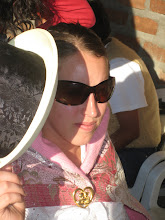In mid-July I visited my friend Val in La Florida, Cajamarca along with fellow volunteers, Sara and Susan. Val’s site is located just over the border between Cajamarca and Lambayeque, at the end of a long agricultural valley. Since her site lies in the foothills, the elevation change along the road up from the coast causes a dramatic shift in scenery. The bumpy 5 hour bus ride provides a good view of the changing ecosystem which transitions from desert to dry forest to wetter dry forest. Once in La Florida, the view is dominated by green hills, bamboo, bananas and coffee plants. Bamboo is the most prominent crop and has almost completely replaced the previously wooded landscape. A monoculture, bamboo eliminates understory growth due to shade and a shallow, interconnected root system.
In La Florida, we stayed at Val’s house, a rambling two story structure filled with incredible amounts of random stuff. Val’s host-mom was extremely welcoming and attempted to feed us every couple of hours. When not eating, I spent my time ramming my head into the awkwardly short doorways.
On day two we took the local bus further up into the mountains to Neipos, a quaint and classic looking sierra town with an beautiful view of the valley below. The ecosystem of Niepos would technically be classified as cloud forest except that there are no longer trees. In general, the Peruvian sierra has suffered an incredibly high amount of deforestation. Glancing across the valley one notices the marked difference between the hillsides. While Neipos is now a treeless landscape dedicated to dairy cattle, across the way the mountains are thickly covered in forest, a glaring reminder of the human impact.
In Neipos, we were privileged to stay in the guest quarters of the local church due to Val’s host-mom’s connections to the Catholic Church. The church itself is 400 years old and an impressive example of the Catholic Church’s colonial efforts. The priest graciously treated us to dinner at a local pensión (house/restaurant where all patrons eat whatever dish was prepared that day.) Unfortunately, the plate of the day was mondongo, pig or cow intestine. However culturally inappropriate it was, our faces froze into similar looks of horror and dismay. I’ve consumed mondongo before and I wouldn’t want to do it again, under any circumstances. Most volunteers have similar sentiments. Hence, Val’s mom took care that all of the intestine was removed and we ate the remaining carrots and potatoes.
The next day we opted to walk back to Val’s site, a pleasant four hour walk down the hillside. On the way down we stopped and visited with Sam Goodman, another volunteer from our group and Val’s sitemate. Sam is currently in his second site, as he was abruptly forced to move from his first when his host-mom was found in bed with the local religion teacher and the family fell apart.
In order to get back to Chiclayo, there were two options: the 1:00AM bus or the 3:00AM bus. We opted for the latter to avoid arriving at Chiclayo at 5:00AM. No buses leave La Florida by day, as the majority of the people who travel to Chiclayo are transporting goods for the market and prefer to arrive by early morning. Sleeping on the bus was next to impossible as every new passenger was wide awake and chose to loudly greet all of the other passengers upon boarding.
Monday, August 17, 2009
Subscribe to:
Post Comments (Atom)

No comments:
Post a Comment